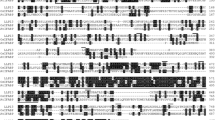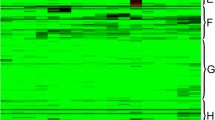Abstract
We have isolated the LLA23 gene in the pollen of Lilium longiflorum. The LLA23 gene encodes an ASR (named after abscisic acid, stress and ripening) protein that has a nuclear localization sequence at the C terminus. The gene is interrupted by one single intron and possesses a long 5′-untranslated region. Southern blots of lily genomic DNA indicated that LLA23 is a member of a small gene family. We examined the link between LLA23 location and the desiccation that naturally occurs in developing anthers using immunogold labeling. When pollen reached maturity, a significant increase in LLA23 labeling was observed in the nuclei of both vegetative and generative cells from 10- to 12-cm buds and thereafter. This clearly demonstrates that a marked increase in LLA23 translocation from the cytoplasm to both nuclei of pollen grains occurs in 12-cm buds, a stage shortly before the commencement of desiccation during anther development. In addition, microarray analysis showed that 410 (206 up-regulated and 204 down-regulated) genes have altered expression in LLA23-overexpressing plants. Quantitative PCR analysis confirmed the changes in mRNA levels observed in our microarray analysis. This genome-wide overview of gene expression supports the theory that LLA23 acts as a regulator.







Similar content being viewed by others
Abbreviations
- ASR:
-
abscisic acid-, stress-, and ripening-induced
- LEA:
-
late embryogenesis abundant
- NLS:
-
nuclear localization signal
- PBS:
-
phosphate-buffered saline
- PBST:
-
PBS containing 0.05% Tween 20
- Q-PCR:
-
quantitative PCR
- TAIL-PCR:
-
thermal asymmetric interlaced PCR
- SDS-PAGE:
-
sodium dodecyl sulfate-polyacrylamide gel electrophoresis
- SSC:
-
NaCl and sodium citrate
- UTR:
-
untranslated region
References
Beaudoin J, Labbé S (2006) Copper induces cytoplasmic retention of fission yeast transcription factor cuf1. Eukaryot Cell 5:277–292
Bolstad BM, Irizarry RA, Astrand M, Speed TP (2003) A comparison of normalization methods for high density oligonucleotide array data based on variance and bias. Bioinformatics 19:185–193
Cakir B, Agasse A, Gaillard C, Saumonneau A, Deirot S, Atanassova R (2003) A grape ASR protein involved in sugar and abscisic acid signaling. Plant Cell 15:2165–2180
Carrari F, Fernie AR, Iusem ND (2004) Heard it through the grapevine? ABA and sugar cross-talk: the ASR story. Trends Plant Sci 9:57–59
Chang S, Puryear JD, Dias MADL, Funkhouser EA, Newton RJ, Cairney J (1996) Gene expression under water deficit in loblolly pine (Pinus taeda): Isolation and characterization of cDNA clones. Physiol Plant 97:139–148
Dure L (1993) Structural motifs in LEA proteins. In: Close TJ, Bray EA (eds) Plant responses to cellular dehydration during environmental stress. American Society of Plant Physiologists, Maryland, pp 91–104
Frankel N, Nunes-Nesi A, Balbo I, Mazuch J, Centeno D, Iusem ND, Fernie AR, Carrari F (2007) ci21A/Asr1 expression influences glucose metabolism in potato tubers. Plant Mol Biol 63:719–730
Frankis R, Mascarenhas JP (1980) Messenger RNA in the ungerminated pollen grains: a direct demonstration of its presence. Ann Bot 45:595–599
Gilad A, Amitai-Zeigerson H, Bar-Zvi D, Scolnik PA (1997) ASR1, a tomato water stress-regulated gene. Genomic organization, developmental regulation and DNA-binding activity. Acta Hortic 447:441–453
Goldgur Y, Rom S, Ghirlando R, Shkolnik D, Shadrin N, Konrad Z, Bar-Zvi D (2007) Desiccation and zinc-binding induces transition of tomato ASR1, a water-stress and salt-stress regulated plant specific protein, from unfolded to folded state. Plant Physiol 143:617–628
Hoekstra FA, van Roekel T (1988) Desiccation tolerance of Papaver dubium L. pollen during its development in the anther: possible role of phospholipid composition and sucrose content. Plant Physiol 88:626–632
Hsu Y-F, Wang C-S, Raja R (2007) Gene expression pattern at desiccation in the anther of Lilium longiflorum. Planta 226:311–322
Huang J-C, Lin S-M, Wang C-S (2000) A pollen-specific and desiccation-associated transcript in Lilium longiflorum during development and stress. Plant Cell Physiol 41:477–485
Itoda M, Saito Y, Soyama A, Saeki M, Murayama N, Ishida S, Sai K, Nagano M, Suzuki H, Sugiyama Y, Ozawa S, Sawada JJ (2002) Polymorphisms in the ABCC2 (cMOAT/MRP2) gene found in 72 established cell lines derived from Japanese individuals: an association between single nucleotide polymorphisms in the 5″-untranslated region and exon 28. Drug Metab Dispos 30:363–364
Iusem ND, Bartholomew DM, Hitz WD, Scolnik PA (1993) Tomato (Lycopersicon esculentum) transcript induced by water deficit and ripening. Plant Physiol 102:1353–1354
Jauh GY, Lord EM (1996) Localization of pectins and arabinogalactan proteins in lily (Lilium longiflorum L.) pollen tube and style and their possible roles in pollination. Planta 199:251–261
Jeanneau M, Gerentes D, Foueillassar X, Zivy M, Vidal J, Toppan A, Perez P (2002) Improvement of drought tolerance in maize: towards the functional validation of the ZM-ASR1 gene and increase of water use efficiency by over-expressing C4-PEPC. Biochimie 84:1127–1135
Kalifa Y, Gilad A, Konrad Z, Zaccai M, Scolnik PA, Bar-Zvi D (2004a) The water- and salt-stress regulated Asr1 gene encodes a zinc-dependent DNA-binding protein. Biochem J 381:373–378
Kalifa Y, Perlson E, Gilad A, Konrad Z, Scolnik PA, Bar-Zvi D (2004b) Over-expression of the water and salt stress-regulated Asr1 gene confers an increased salt tolerance. Plant Cell Environ 27:1459–1468
Larkin JC, Oppenheimer DG, Pollock S, Marks MD (1993) Arabidopsis GLABROUS1 gene requires downstream sequences for function. Plant Cell 5:1739–1748
Liu CC, Lin CC, Chen WS, Chen HY, Chang PC, Chen JJ, Yang PC (2006) CRSD: a comprehensive web server for composite regulatory signature discovery. Nucleic Acids Res 34:W571–W577
Liu YG, Whittier RF (1995) Thermal asymmetric interlaced PCR: automatable amplification and sequencing of insert end fragments from P1 and YAC clones for chromosome walking. Genomics 25:674–681
Maliga P, Klessig DF, Cashmore AR, Gruissem W, Varner JE (1995) Methods in plant molecular biology. A laboratory course manual. Cold Spring Harbor Laboratory Press, Cold Spring Harbor, NY
Maskin L, Gubesblat GE, Moreno JE, Carrari FO, Frankel N, Sambade A, Rossi M, Iusem ND (2001) Differential expression of the members of the Asr gene family in tomato (Lycopersicon esculentum). Plant Sci 161:739–746
Maskin L Frankel N, Gudesblat G, Demergasso MJ, Pietrasanta LI, Iusem ND (2007) Dimerization and DNA-binding of ASR1, a small hydrophilic protein abundant in plant tissues suffering from water loss. Biochem Biopsy Res Commun 352:831–835
Riccardi F, Gazeau P, de Vienne D, Zivy M (1998) Protein changes in response to progressive water deficit in maize. Plant Physiol 117:1253–1263
Sambrook J, Fritsch EF, Maniatis T (1989) Molecular cloning: a laboratory manual, 2nd edition.. Cold Spring Harbor Laboratory Press, Cold Spring Harbor, NY
Schneider A, Salamini F, Gebhardt C (1997) Expression patterns and promoter activity of the cold-regulated gene ci21A of potato. Plant Physiol 113:335–345
Silhavy D, Hutvágner G, Barta E, Bánfalvi Z (1995) Isolation and characterization of a water-stress-inducible cDNA clone from Solanum chacoense. Plant Mol Biol 27:587–595
Smith DE, Fisher PA (1984) Identification, developmental regulation, and response to heat shock of two antigenetically related forms of a major nuclear envelope protein in Drosophila embryos: application of an improved method for affinity purification of antibodies using polypeptides immobilized on nitrocellulose blots. J Cell Biol 99:20–28
Vaidyanathan R, Kuruvilla S, Thomas G (1999) Characterization and expression pattern of an abscisic acid and osmotic stress responsive gene from rice. Plant Sci 140:25–36
Wang C-S, Wu T-D, Chung C-KW, Lord EM (1996) Two classes of pollen-specific, heat-stable proteins in Lilium longiflorum. Physiol Plant 97:643–650
Wang C-S, Liau Y-E, Wu T-D, Su C-C, Huang J-C, Lin CH (1998) Characterization of a desiccation-related protein in lily pollen during development and stress. Plant Cell Physiol 39:1307–1314
Wang H-J, Hsu C-M, Jauh GY, Wang C-S (2005) A lily pollen ASR protein localizes to both cytoplasm and nuclei requiring a nuclear localization signal. Physiol Plant 123:314–320
Willing RP, Bashe D, Mascarenhas JP (1988) An analysis of the quantity and diversity of messenger RNAs from pollen and shoot of Zea mays. Theor Appl Genet 75:751–753
Yang C-Y, Chen Y-C, Jauh GY, Wang C-S (2005) A lily ASR protein involves abscisic acid signaling and confers drought and salt resistance in Arabidopsis. Plant Physiol 139:836–846
Acknowledgment
We thank Y.-F. Hsu for his able technical assistance. This work was supported by the National Science Council grant NSC95-2311-B005-006-MY3 to Co-Shine Wang.
Author information
Authors and Affiliations
Corresponding author
Additional information
The nucleotide sequence data of the LLA23 gene reported here will appear in the EMBL, GenBank and DDBJ Nucleotide Sequence Databases under the accession number EU652722.
Rights and permissions
About this article
Cite this article
Yang, CY., Wu, CH., Jauh, G.Y. et al. The LLA23 protein translocates into nuclei shortly before desiccation in developing pollen grains and regulates gene expression in Arabidopsis. Protoplasma 233, 241–254 (2008). https://doi.org/10.1007/s00709-008-0016-5
Received:
Accepted:
Published:
Issue Date:
DOI: https://doi.org/10.1007/s00709-008-0016-5




